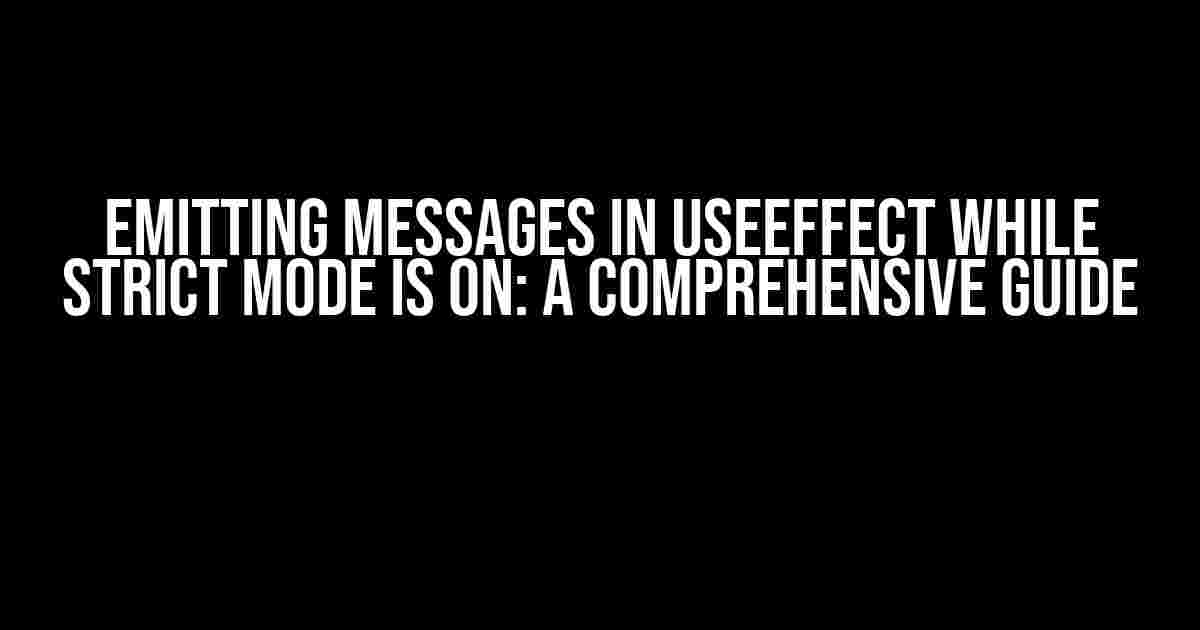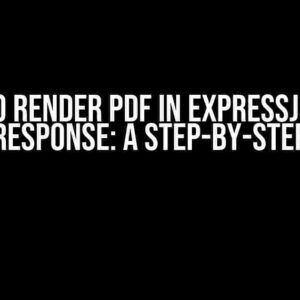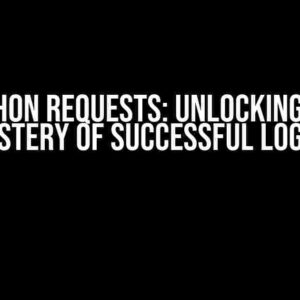Are you tired of seeing those pesky warnings in your console when using useEffect in Strict Mode? Do you want to learn how to emit messages in useEffect while keeping your code clean and efficient? Look no further! In this article, we’ll dive into the world of useEffect and Strict Mode, exploring the reasons behind those warnings and providing you with step-by-step instructions on how to emit messages safely and correctly.
What is Strict Mode?
Before we dive into the meat of the article, let’s take a step back and understand what Strict Mode is and why it’s essential in React development. Strict Mode is a feature in React that helps you identify and fix potential issues in your code, such as:
- Accidental mutations of the state
- Component lifecycle methods that have side effects
- Unused values in the state or props
- Unexpected changes in the DOM
When you enable Strict Mode, React will react (pun intended) more strictly to your code, throwing warnings and errors when it detects potential issues. This helps you write better, more maintainable code and avoid common pitfalls.
The useEffect Hook and Strict Mode
The useEffect hook is a powerful tool in React that allows you to perform side effects, such as making API calls, setting timers, or updating the DOM, in functional components. However, when you use useEffect in Strict Mode, you might notice that React throws warnings about “Invalid hookup of useEffect” or “useEffect has a missing dependency”. These warnings are related to the way useEffect handles side effects and dependencies.
In strict mode, React will run the useEffect hook twice in development mode to detect any potential issues. This is known as the “double invoke” behavior. The first run is used to detect and warn about potential issues, while the second run is used to actually execute the effect.
The Problem: Emitting Messages in useEffect
So, what’s the problem with emitting messages in useEffect while Strict Mode is on? The issue arises when you try to emit a message, such as a console.log statement or an API call, inside the useEffect hook. Because of the double invoke behavior, React will run the effect twice, causing the message to be emitted twice as well.
This can lead to unintended consequences, such as:
- Duplicate API calls, which can cause performance issues and increase latency
- Unnecessary console.log statements, which can clutter your console and make debugging more difficult
- Incorrect results, as the effect might be run multiple times, leading to unexpected behavior
The Solution: Emitting Messages Safely in useEffect
So, how can you emit messages safely in useEffect while keeping Strict Mode on? There are a few approaches you can take:
1. Use a Ref to Track the Invocation
One way to emit messages safely is to use a ref to track the invocation of the useEffect hook. By using a ref, you can ensure that the message is only emitted once, even in Strict Mode.
import { useState, useEffect, useRef } from 'react';
function MyComponent() {
const [count, setCount] = useState(0);
const invoked = useRef(false);
useEffect(() => {
if (!invoked.current) {
console.log('Effect invoked!');
invoked.current = true;
}
}, []);
return (
Count: {count}
);
}
In this example, we use a ref called `invoked` to track whether the effect has been invoked before. If it hasn’t, we emit the message and set the ref to `true`. This way, the message is only emitted once, even in Strict Mode.
2. Use a Dependency Array
Another approach is to use a dependency array to control when the effect is run. By adding a dependency to the array, you can ensure that the effect is only run once, even in Strict Mode.
import { useState, useEffect } from 'react';
function MyComponent() {
const [count, setCount] = useState(0);
const [invoked, setInvoked] = useState(false);
useEffect(() => {
if (!invoked) {
console.log('Effect invoked!');
setInvoked(true);
}
}, [invoked]);
return (
Count: {count}
);
}
In this example, we use a state variable `invoked` to track whether the effect has been invoked before. We add `invoked` to the dependency array, so that the effect is only run once, when `invoked` is `false`.
3. Use the `useCallback` Hook
A third approach is to use the `useCallback` hook to memoize the function that emits the message. This way, even if the effect is run multiple times, the memoized function will only be executed once.
import { useState, useEffect, useCallback } from 'react';
function MyComponent() {
const [count, setCount] = useState(0);
const emitMessage = useCallback(() => {
console.log('Effect invoked!');
}, []);
useEffect(() => {
emitMessage();
}, []);
return (
Count: {count}
);
}
In this example, we use `useCallback` to memoize the `emitMessage` function. We then call the memoized function inside the effect, ensuring that it’s only executed once, even in Strict Mode.
Conclusion
Emitting messages in useEffect while Strict Mode is on can be a challenging task, but with the right approaches, you can ensure that your code is efficient, clean, and maintainable. By using a ref, a dependency array, or the `useCallback` hook, you can emit messages safely and correctly, even in Strict Mode.
Remember, Strict Mode is your friend, and it’s there to help you write better code. By understanding how it works and adapting your code accordingly, you can take your React development to the next level.
Frequently Asked Questions
Q: Why does React run the useEffect hook twice in Strict Mode?
A: React runs the useEffect hook twice in Strict Mode to detect and warn about potential issues, such as accidental mutations of the state or component lifecycle methods that have side effects.
Q: What is the purpose of the double invoke behavior in Strict Mode?
A: The double invoke behavior is used to detect and warn about potential issues in your code, helping you write better, more maintainable code and avoid common pitfalls.
Q: How can I ensure that my useEffect hook is only run once in Strict Mode?
A: You can use a ref, a dependency array, or the `useCallback` hook to ensure that your useEffect hook is only run once in Strict Mode.
| Approach | Description |
|---|---|
| Using a Ref | Track the invocation of the useEffect hook using a ref |
| Using a Dependency Array | Add a dependency to the array to control when the effect is run |
| Using useCallback | Memoize the function that emits the message using useCallback |
We hope this comprehensive guide has helped you understand the intricacies of emitting messages in useEffect while Strict Mode is on. By following these approaches, you can ensure that your code is efficient, clean, and maintainable.
Happy coding!
Frequently Asked Questions
Get the inside scoop on emitting messages in useEffect while strict mode is on!
What happens when I emit messages in useEffect with strict mode on?
When you emit messages in useEffect with strict mode on, React will re-run the effect function multiple times to detect and warn about potential side effects. This can lead to unexpected behavior, such as duplicate messages being sent or errors being thrown.
Why does React re-run the effect function in strict mode?
React re-runs the effect function in strict mode to ensure that the effect is pure and doesn’t have any unintended side effects. This helps catch bugs and inconsistencies that might arise from stale closures or other issues.
How can I avoid emitting messages in useEffect with strict mode on?
To avoid emitting messages in useEffect with strict mode on, you can either disable strict mode or wrap your effect function in a useCallback or useMemo hook to memoize the function and prevent it from being re-run.
What are the consequences of not handling emitting messages in useEffect properly?
If you don’t handle emitting messages in useEffect properly, it can lead to performance issues, errors, and unexpected behavior in your application. In extreme cases, it can even cause your app to crash or become unresponsive.
Are there any best practices for handling emitting messages in useEffect?
Yes, always wrap your effect function in a useCallback or useMemo hook to memoize the function and prevent it from being re-run. Additionally, consider using the useEffect cleanup function to cancel any pending messages or requests when the component is unmounted.



